This article was published in Scientific American’s former blog network and reflects the views of the author, not necessarily those of Scientific American
London’s Natural History Museum (the NHM) is one of the world’s greatest and most famous of natural history museums, and one thing the museum is synonymous with is dinosaurs. Even without its soon-to-be-touring Diplodocus replica, the museum is still home to both a dinosaur display gallery that brings in millions of visitors each year, and to one of the world’s most important scientific collections of dinosaur fossils.
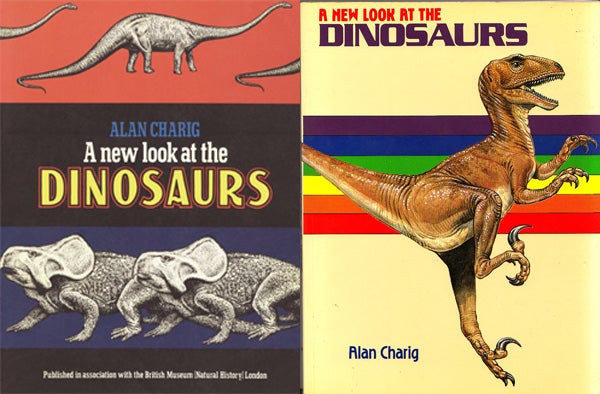
Covers of just two of the several editions of Alan Charig's A New Look at the Dinosaurs, in print between 1979 and 1988 at least (there might have been a 1990 edition). Credit: Charig 1979
So it stands to reason that the museum has long been associated with books that seek to educate and entertain the public as goes the world of dinosaurs and their ilk. For years, William Swinton’s Fossil Amphibians and Reptiles was the museum’s main offering. It was reprinted on numerous occasions following its publication in 1954. Then there was Alan Charig’s A New Look at the Dinosaurs, first published in 1979 and also reprinted as numerous later editions.
On supporting science journalism
If you're enjoying this article, consider supporting our award-winning journalism by subscribing. By purchasing a subscription you are helping to ensure the future of impactful stories about the discoveries and ideas shaping our world today.
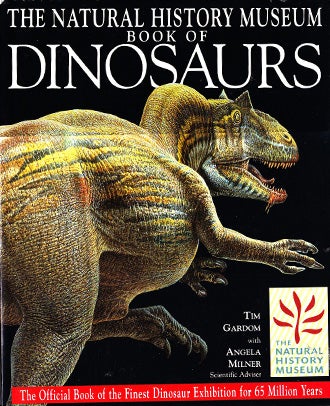
Cover of original edition of Gardom & Milner (1993). It looks a bit odd because I had to scan it in two parts. Credit: Gardom & Milner 1993
By the 1990s, Charig’s rather technical tome was looking dated (see Moody & Naish 2010) and the time was right for a more popular, prettier volume. And thus Tim Gardom and Angela Milner’s 1993 The Natural History Museum Book of Dinosaurs came to pass. Gardom & Milner (1993) is not bad at all as a popular-level volume and ran for three editions, the newest appearing in 2007.
But the time came when it, too, began to look dated (check out all those scaly-skinned maniraptorans). A new book was needed, and the task of writing it fell to current NHM dinosaur expert Paul Barrett... who, so kindly, approached the present author with an offer of collaboration. And thus it was that we teamed up and wrote what might just be the best popular-level dinosaur book written so far*.
* As usual: a nod to worthy predecessors. Check out Thomas Holtz’s Dinosaurs: The Most Complete, Up-to-Date Encyclopedia for Dinosaur Lovers of All Ages and Farlow et al.’s The Complete Dinosaur (2nd edition) if you can.
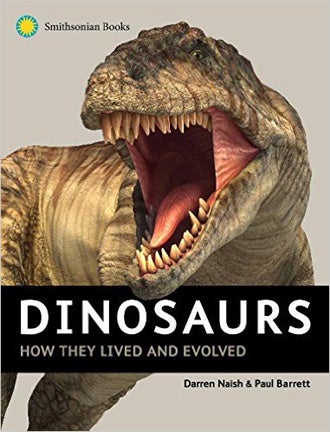
This is the cover of the US edition (where it's published by the Smithsonian, not the NHM). Credit: Naish & Barrett 2016
Our new book – Dinosaurs: How They Lived and Evolved (Naish & Barrett 2016) – is a sturdy hardback of some 224 pages. It’s extensively illustrated in colour throughout and features scores of photos, diagrams and life reconstructions. There’s a lot of text, the style of which is mostly pitched at older teenagers and adults but which could easily be followed by a smart person of 11 or 12. Having said this, an interested kid of 10 could follow it too. I cannot yet confirm plans for a softback, nor do I know anything about a digital version (follow me on twitter for news: @TetZoo).
The contents. The six chapters variously cover (1) History, Origins and their World, (2) The Dinosaur Family Tree, (3) Anatomy, (4) Biology, Ecology and Behaviour, (5) The Origin of Birds, and (6) The Great Extinction and Beyond. Let’s talk about the contents of those chapters a little. Chapter 1 features the preamble you expect for a dinosaur book: there’s a little bit about taxonomy and geological time, the popularity of dinosaurs, and a brief look at the science of dinosaur research and at what sort of things experts aim to find out.
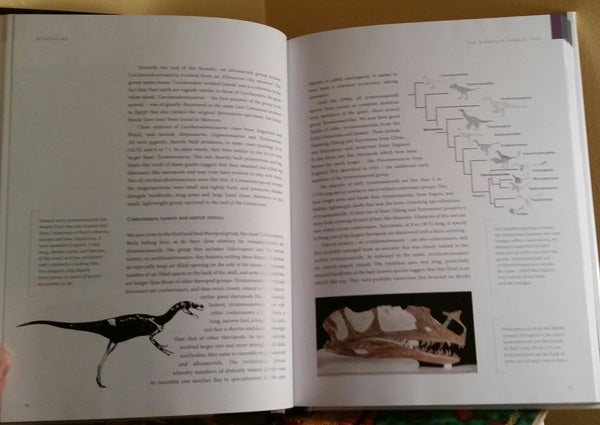
Pages from Naish & Barrett (2016) featuring tyrannosauroids: that's Eotyrannus at left and Proceratosaurus at right. Credit: Naish & Barrett 2016
We also get one thing out of the way right up-front – on the third page of text in fact. This is the fact that birds are dinosaurs, and thus that dinosaurs are not extinct and that constant reference has to be made to ‘non-bird dinosaurs’ where appropriate. It is, in my view (and Paul’s), misleading and downright wrong to ignore birds when discussing the group termed Dinosauria.
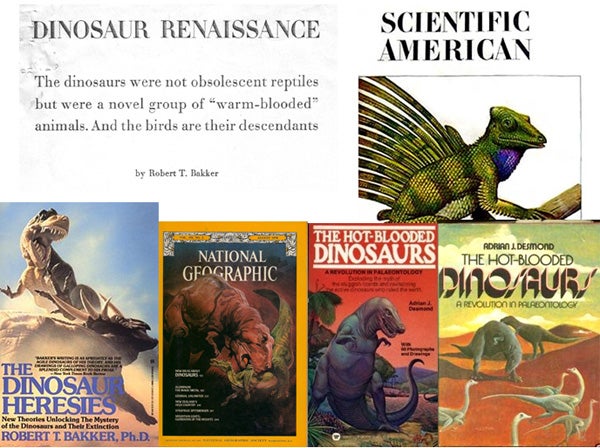
A montage of Dinosaur Renaissance images: book and magazine articles and an excerpt from Bakker’s 1975 Scientific American article. Credit: Bakker 1975, Desmond 1975, Bakker 1986
The rest of that first chapter reviews the history of dinosaur research. We are in a post-Bakkerian world where, again, it is wrong to pretend that the writings of Ostrom and Bakker – whatever you make of them – did not inspire that which followed, and so it is that we have a section on the impact of their work during the late 20th century. As we note, however, things might actually have been more complex and more study is needed. Anyway, cue the graph showing how more than 85% of recognised non-bird dinosaurs have been named since 1990. Also from the intro chapter: we briefly discuss Mesozoic climate, weather and palaeobiogeography. Things have turned out to be less simple than people used to think. Cool temperatures during part of the Mesozoic? Dinosaurs specialised for life on island continents? Dinosaurs in polar regions during prolonged periods of seasonal darkness?
Our anatomy chapter aims to bring many of the ideas familiar to specialist dinosaur researchers to a broader audience: think of all that work on neck flexibility, tail musculature and tail flexibility, on the saurischian pneumatic system and so on that’s there in the technical literature but little known to lay-readers. We make use of those sexy diagrams by Mike Taylor and Heinrich Mallison that depict sauropod neck and stegosaur tail flexibility, respectively.
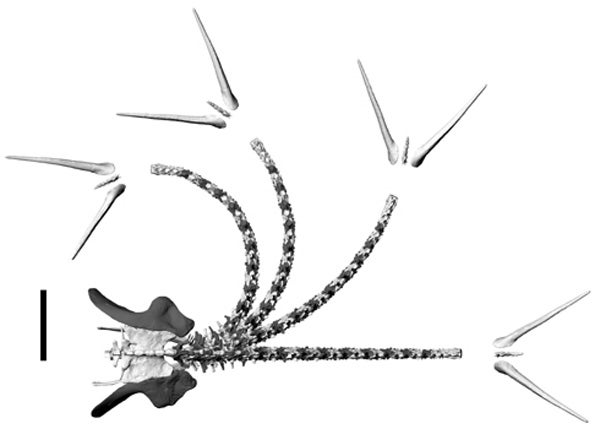
Heinrich Mallison's digital reconstruction of the lateral tail movement possible in the tail of the stegosaur Kentrosaurus. Credit: Mallison 2010, Naish & Barrett 2016
Biology, ecology, behaviour. I suspect that a favourite chapter for many will be the one on biology, ecology and behaviour. If you’re familiar with Paul’s research, and my own interests and research interests, you might guess what the contents include. We cover the increasingly complex world of ornithischian feeding biology and jaw function, the debate on diplodocid feeding behaviour (spoiler: maybe anything goes), maniraptoran predation and use of those sickle-claws, finite element analysis and its application, locomotion and running speed, sexual selection, parental care, ontogeny, the composition of dinosaur communities… and more.
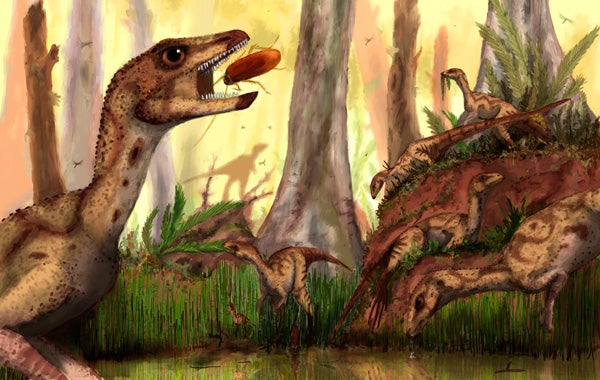
The early ornithischian Laquintasaura venezuelae, as depicted by Mark Witton and as seen in Naish & Barrett (2016). Mark has recently produced an updated version of this illustration where the beasts sport a filamentous covering... but we don't feature that version in the book. Credit: Mark Witton, Naish & Barrett 2016
Many of the things that will be new to a generalist readership will be familiar to readers of this blog: the ‘ontogenetic morphing hypothesis’ as it pertains to pachycephalosaurs (yes) and chasmosaurines (well, ok… except for that Torosaurus idea), Just Say No To Nanotyrannus, kids, the race-to-death in Tyrannosaurus (longevity of less than 30 years), and the idea of aquatic or amphibious life in Spinosaurus… we’re sceptical of the Ibrahim et al. idea, and we wrote what we did before Evers et al. (2015) appeared. We’re a bit open-ended on the issue of dinosaur physiology. I think that the evidence indicating full-blown physiological endothermy (and not just inertial endothermy) in at least some non-bird dinosaurs is good (Pontzer et al. 2009) but I’m also not offended by the idea that a more intermediate ‘mesothermy’ (Grady et al. 2014) might have applied to some lineages.
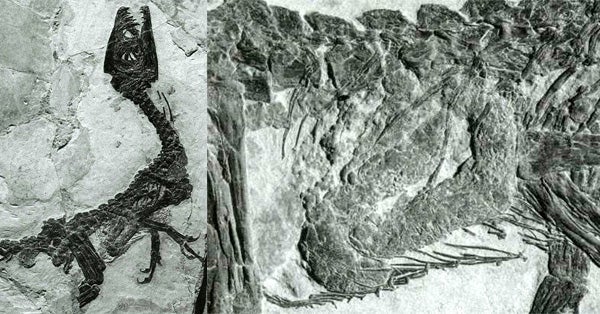
Scipionyx, the amazing juvenile theropod that even has its intestines preserved (you can see them at right). These black and white images are from Dal Sasso & Signore (1998) - we have even better, colour images in the book. Credit: Dal Sasso & Signore 1998
The Cenozoic has dinosaurs too. People who read my stuff (here at Tet Zoo or in various books: see Naish 2012) will know that I consider it important that the Cenozoic history of birds should be included in any review of dinosaur diversity that allows it. All too often authors stop with Cretaceous lineages, meaning that interested parties have no option but to turn to Feduccia’s books when it comes to post-Cretaceous birds, and those works are as misleading on Cenozoic birds as they are on bird origins and the Mesozoic history of birds. Anyway, our last chapter includes a brief review of post-Mesozoic bird history and diversity that I think does a pretty good job. It ends with chickens. Always with the chickens. There are over 20 billion of them in the world right now, you know.
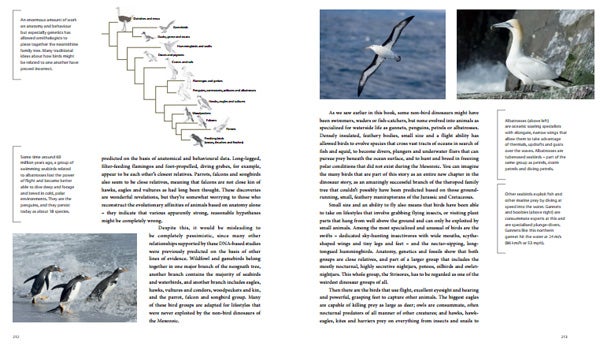
Some of the bird pages from Naish & Barrett (2016). Dinosaurs that took to life at sea are among the most incredible of dinosaurs ever. Credit: Naish & Barrett 2016
As for the extinction event, Paul and I endorse the ‘integrated scenario’: the idea that it was the giant rock from outer space that mostly killed all those animals, but that other issues of the time had already put them in a very vulnerable place.
How awesome is this book exactly? Reviewers respond. What have people said about the text so far? People seem to like the way it’s pitched and the stuff it covers. I have to say that I roll my eyes when I see reviewers making (as one has) some snide aside to our apparent use of the “passive voice”. I know what ‘passive voice’ means and I avoid it where I can, but it gets so frequently called out as a criticism of scientific writing (my own included) that it no longer means anything to me and I’m not sure that it can be avoided when writing about science.
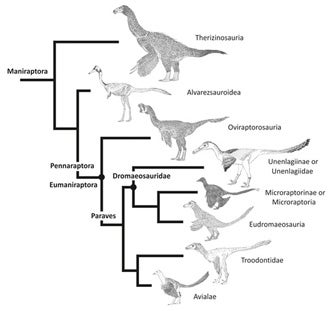
The book includes various of my cladograms, which look something like this one. Credit: Darren Naish
I saw one review which claimed that the “least successful” chapter is the one on the dinosaur family tree (Chapter 2). I find that description amusing: reviewers (who typically review books because they review books, not because they’re especially interested in the book or its subject) tend not to get that the let’s-walk-through-the-family-tree section of a book is often one of the highlights for dinosaur fans, and I can’t see that this subject (nor our review specifically) is dry or monotonous. What, you think that disagreements over the evolutionary position of heterodontosaurids are boring? Huh, I do not envy your view of reality, my friend. And, checking that chapter again in an effort to quell my paranoia, I find it pretty satisfying: when discussing a relevant group, we talk about its anatomy, palaeobiology and inferred lifestyle, it’s not just a “group x gave rise to give y which gave rise to group z” tirade of tree structure and nothing else.
Let’s talk about the pictures. OK, the Giganotosaurus in the room is the cover. I will say that I don’t like it, but I don’t want to say much more than that, other than that I bowed to pressure and recognised that – aesthetics aside – the image was chosen for reasons of impact. I will remind those who dislike the image not to judge a book by its cover.
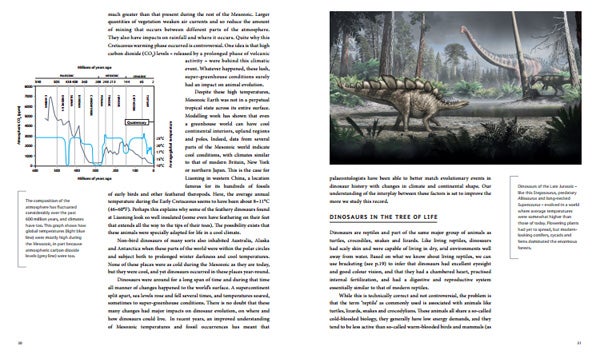
That's a pretty respectable picture to text ratio right there. The illustration on the right is by Bob Nicholls. Credit: Naish & Barrett 2016
And indeed… the artwork elsewhere in the book includes some of the best, most cutting-edge content produced by anyone. Excellent pieces by Bob Nicholls (some of them brand new), Emily Willoughby, John Conway, Julius Csotonyi, Mark Witton, Andrey Atuchin, Davide Bonadonna, John Sibbick and Berislav Krzic appear. My cladograms feature throughout. Even if you don’t want to read the text you might buy the book for its pictures alone, I feel.
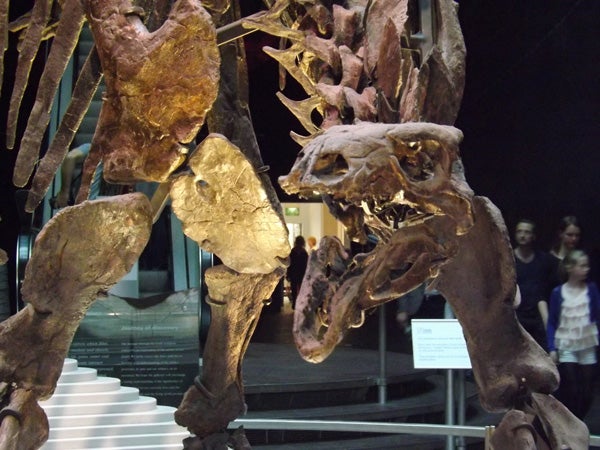
Sophie, the NHM's amazing Stegosaurus, features in several places in the book, as does the science published so far on this significant specimen. Credit: Darren Naish
This book is also packed with excellent colour photos and features a great many of the NHM’s prize dinosaur specimens (many of which are not on display but in the collections). Among my favourites are the Stegoceras skull (one of the most complete pachycephalosaur skulls in the world), the Proceratosaurus and Baryonyx holotypes, Cutler’s amazing Scolosaurus specimen (an image I was sadly unable to procure for the relevant section of my 2012 The Great Dinosaur Discoveries) and the many images of Sophie the famous Stegosaurus. Non-NHM specimens put to good use include the Erlikosaurus skull, Scipionyx (thanks to Cristiano Dal Sasso and Simone Maganuco for those pictures), the bristle-tailed Psittacosaurus you all know and love, the quill knobs of Velociraptor and the gracile hand of Berlin’s Giraffatitan.
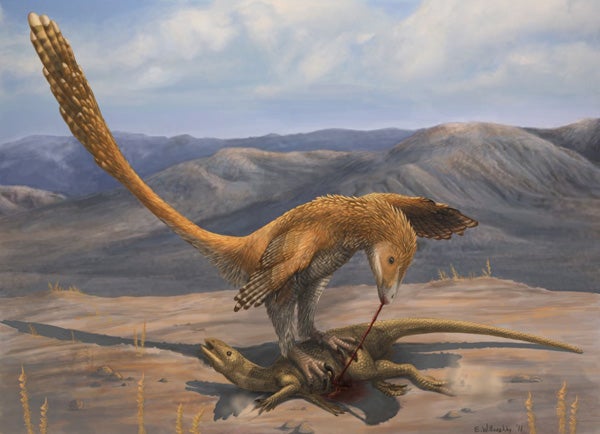
Deinonychus dispatching/eating an unfortunate ornithischian, one of several Emily Willoughby illustrations included in the book. Credit: Emily Willoughby, Naish & Barrett 2016
Sometimes, tracking down the images took quite some effort. The NHM might be home to many of the world’s most awesome dinosaur fossils but that doesn’t mean that good photos of the specimens (which are often on display behind glass, or in deep storage and awkward to pull out) are readily available. A tip-off from Dean Lomax (author of the recent Dinosaurs of the British Isles) led to the discovery of the excellent colour, whole-specimen shot of the Scelidosaurus I wanted.
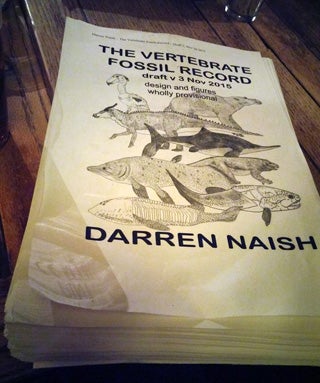
The draft of a book that, at last count, was over 700 pages long... Credit: Darren Naish
And I think that will do. I hope people like the book; initial indications from reviews online and word of mouth is that they do. For a particularly nice review I will point you to Marc Vincent’s at Love in the Time of Chasmosaurs. Finally, there are a few minor typos that I wish we’d caught (“titonosaurs” in one figure caption… d’oh!), but it’s hard to be perfect.
So – what’s next? Ah yes, that…
Darren Naish & Paul Barrett. 2016. Dinosaurs: How They Lived and Evolved. The Natural History Museum/Smithsonian Book. £18.00/$29.95. Hardback, index, glossary, pp. 224. ISBN 978-0-56509311-2. Here from the Natural History Museum.Here on amazon.Here on amazon.co.uk (I have no idea why amazon.co.uk are selling it at £24, retail price is £18.00).
For previous articles relevant to things mentioned here, see...
Extinction: Not the End of the World at London’s Natural History Museum
After 75 Years, 6-Ton Blue Whale Model Still Excites London Museum
Getting a major chapter on birds ALL birds into a major book on dinosaurs
New Books on Dinosaurs 2: Dean Lomax and Nobumichi Tamura's Dinosaurs of the British Isles
Refs - -
Bakker, R. T. 1975. Dinosaur renaissance. Scientific American 232 (4), 58-78.
Bakker, R. T. 1986. The Dinosaur Heresies. Penguin Books, London.
Evers, S. W., Rauhut, O. W. M., Milner, A. C., McFeeters, B. & Allain, R. 2015. A reappraisal of the morphology and systematic position of the theropod dinosaur Sigilmassasaurus from the “middle” Cretaceous of Morocco. PeerJ 3:e1323 https://doi.org/10.7717/peerj.1323
Gardom, T. & Milner, A. 1993. The Natural History Museum Book of Dinosaurs. Virgin Books, London.
Grady, J. M., Enquist, B. J., Dettweiler-Robinson, E., Wright, N. A. & Smith, F. A. 2014. Evidence for mesothermy in dinosaurs. Science 344, 1268-1272.
Moody, R. T. J. & Naish, D. 2010. Alan Jack Charig (1927-1997): an overview of his academic accomplishments and role in the world of fossil reptile research. In Moody, R. T. J., Buffetaut, E., Naish, D. & Martill, D. M. (eds) Dinosaurs and Other Extinct Saurians: A Historical Perspective. Geological Society, London, Special Publications 343, pp. 89-109.
Naish, D. & Barrett, P. M. 2016. Dinosaurs: How They Lived and Evolved. The Natural History Museum, London.